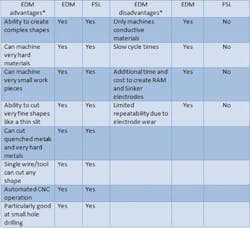Ultrashort-pulse laser micromachining or EDM: What's right for the job?
Ultrashort-pulse (USP) laser micromachining is displacing electronic discharge machining (EDM) in some applications
BILL PEATMAN
Micromachining is a critical part of bringing new automotive, medical, semiconductor, and aerospace products to market. Achieving the designs for next-generation fuel injectors, coronary stents, and high-density micro-holes requires precision and cycle times beyond what is possible using older electronic discharge machining (EDM) equipment.
Precision features in seconds
Commercialized femtosecond laser technology is making these designs possible and economically feasible. Femtosecond (one quadrillionth of a second) pulses of light precisely remove material without physical contact to the part and without generating heat. Heatless, touchless machining instantly creates precision features in a single step—with no thermal or mechanical damage and no-post processing needed to finish the part.
Femtosecond laser micromachining platforms are replacing EDM and other slower laser systems in multiple applications. In a 2010 report, "EDM: Ram-Type and Small Hole," market research firm Dedalus Consulting studied the worldwide EDM market. Their report begins with a summary of the advantages and disadvantages of EDM machining. New femtosecond laser (TABLE, with "femtosecond laser" represented as "FSL") solutions have most of the advantages of EDM, and none of the disadvantages.
EDM strengths
EDM, which uses an electrical charge to remove material, has proven effective at machining hard metals, and can achieve tighter tolerances than the technology it replaced—mechanical drilling or punching.
As noted in the report, EDM machining equipment makes is possible to cut small, odd-shaped angles, detailed contours, or cavities in hardened steel as well as exotic metals like titanium, Hastelloy, Kovar, Inconel, and carbide. The EDM process is commonly used in the tool and die industry for mold making—however, in recent years, EDM has become an integral part for making prototype and production parts. This is seen in the aerospace and electronics industries where production quantities remain low.
EDM limitations
EDM does have some limitations—for example, this process can only machine conductive materials. Because EDM uses heat to remove material significant recast can occur and post-processing may be required to ultimately meet manufacturers' specifications for part quality.
Also, because the EDM electrode wears over time, resulting contours may be uneven, so electrodes must be replaced periodically. The combination of electrode wear and material recast also requires constant flushing of the work area because of debris buildup.
The FIGURE shows an example of femtosecond laser athermal machining, where the left-hand image shows three grooves milled into the surface of stainless steel and the image at right is an even-higher-magnification SEM image of the cross-section of one of the groove sidewalls. The dark part of the image is where material has been removed by femtosecond laser ablation, and the light part is the remaining metal, which has been chemically treated to expose the metal’s grain structure. The grain structure is unchanged all the way to the edge where the ablation took place. There is no sacrifice of material integrity and no need for post-processing to remove heat-affected zone (HAZ).
New laser solution
In recent years, a new class of USP laser micromachining platform has emerged that is optimized for industrial applications. For example, Microlution (a subsidiary of GF Machining Solutions) has developed a workstation that combines high stability, precision motion control, and part handling that enables ultrafast lasers housed in the platform to machine with extreme accuracy and repeatability. The platform can be configured to drill, mill, and cut without HAZ to deliver precision parts in seconds. This product, called the ML-5 for its five axes of motion (see https://goo.gl/snQcTF), is at work in automotive, medical, consumer product, life sciences, and semiconductor industries around the world.
Applications where the laser solution has delivered improved manufacturing processes include drilling nozzles for gas direct injection (GDI) fuel injectors, and for machining the tips of irrigating medical catheters used in coronary ablation. In both cases, accurate fluid delivery is made possible by faster, more precise machining. Accuracy is enhanced with inline part measurement and validation.
*Source: Dedalus Consulting
BILL PEATMAN([email protected]) is with Microlution, Chicago, IL; www.microlution.com.


